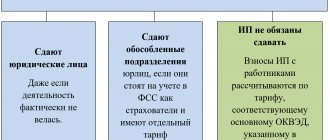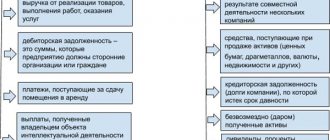Where in accounting can I see the reflection of income?
In what accounts is revenue reflected? Revenue from ordinary activities is grouped on account 90 “Sales” , other revenue is shown on account 91 “Other income and expenses”. Ordinary activities are those that an organization engages in continuously or systematically.
Other revenue in accounting is revenue from the sale of any assets of the organization. This could be the sale of fixed assets, construction in progress, materials, financial investments, accounts receivable, currency - any assets that the organization deems necessary to sell.
Let's analyze the postings for account 90 using an example
In the reporting period, the company showed sales of its own products in the amount of 322,000 rubles. (excluding VAT), the cost of which is 243,000 rubles. Funds from the sale are credited to the current account, and the period is closed.
Postings with a score of 90 will look like this:
- 62 is debited and 90.1 is credited for 322,000 rubles. (amount of revenue).
- According to D90.2 and K41 for 243,000 rubles. (cost amount).
- D51 - K62 upon receipt of funds to pay for the goods 322,000 rubles.
- The characteristics of account 90 suggest its closure:
D90.1 – K90.9 in the amount of 322,000 rubles;
- D90.9 – K90.2 in the amount of 243,000 rubles;
- D90.9 – K99 in the amount of 79,000 rubles. (322,000-243,000).
Why does it apply to credit 90 and 91?
The division of income into “regular” and “other” is not established by law ; each organization determines them independently.
Important . The usual type of activity is not the one that the organization ascribes to in the Charter and makes it the main one when registering, but the one that is actually carried out.
In general, income from ordinary activities for manufacturing organizations includes the sale of manufactured products, for retail organizations - the sale of goods, for transport organizations - the sale of transport services. Then the rental income from such organizations will be other income if the rental of property is unsystematic (for example, a production organization leases temporarily unused production space or equipment). We talked about how revenue differs from income and other accounting concepts in this material.
But if leasing is the main activity of the organization (for example, cars are purchased for rent to taxi drivers), real estate is purchased by an agency for resale, then such income is accounted for using account 90. Proceeds from the sale of everything else are credited to account 91 (as is considered you will find out such sales revenue here). For certainty, an organization can prescribe the types of income from ordinary activities and others in its accounting policies.
What accounting accounts are provided to reflect sales?
Studying the chart of accounts, valid on the basis of Order of the Ministry of Finance of the Russian Federation dated October 31, 2000 No. 94n, we can identify the accounts that should be used to reflect the sale of assets:
- 90 with the laconic name “Sales”;
- 91, which is called “Other income and expenses”.
The 90th account passes through all sales related to the main areas of the company’s work: trade in goods, own manufactured products, work performed or services provided.
In addition to reflecting the fact of sales when writing entries in correspondence with the debit of account 62, it is used to write off the cost of goods sold or products, works or services. In the 2nd case, it is used in conjunction with the credit of accounts 43, 41, 44, 20.
All side income from transactions and operations that are not typical for the company are reflected in account 91. For example, these are additional funds from the provision of property for rent (if renting is not the main activity of the company), the sale of unused non-current assets, fines for won legal disputes or transactions, conditions which were violated. Sales also take place in combination with the debit of accounts 62 or 76. The accumulated cost or sales expenses are written off by debiting the account in correspondence with cost or material accounts (01, 10, etc.).
What does the Plan correspond to?
Account 91 itself is active-passive, revenue from other sales is reflected in the credit of the account, in subaccount 91.1 “Other income”. Amounts of income from the sale of other property are reflected in the credit of account 91.1 in correspondence with account 62 “Settlements with buyers and customers” or with account 76 “Settlements with other debtors and creditors”.
Revenue is reflected on the credit of account 91.1 in the full amount presented to the buyer and reflected in the sales documents (waybill, invoice or UPD), regardless of the fact of payment.
From separate publications on our website dedicated to revenue, you can find out how it is accounted for with and without VAT, how to display and view monthly revenue in 1C, what formulas are used for calculation and how to find out its annual volume.
Why do we need count 90?
Account 90 “Sales” is needed to collect information on the sale of goods or services. Revenue and expenses from such operations are recorded here:
- sale of finished products or goods for resale;
- provision of various services: construction, installation, transport and so on;
- execution of work;
- rental of property;
- participation in the authorized capital of another company, and so on.
Count 90 is an active-passive count. Its debit records income, and its credit records expenses. The difference between a debit and a credit is the company's profit or loss.
Analytical accounting
Analytics for account 91 is carried out by type of income and expenses. The level of detail is determined by the organization independently. For example, you can indicate the income/expense item “Sale of other property”, or you can group it separately: “Sale of fixed assets”, “Sale of materials”, “Sale of other assets”.
From the point of view of preparing financial statements, there is no difference between these options, and from the point of view of using accounting data in management accounting or for tax reporting, the second option is preferable. You will learn how revenue is displayed in accounting records in this article, and we will talk about where the revenue line can be found in the balance sheet in a separate article.
Which accounts does account 90 correspond to?
The list of accounts with which account 90 can correspond is huge. This is due to the fact that most of the operations are aimed at making a profit in one way or another. In the table we have collected all possible correspondence options.
| By debit | By loan |
| 11 “Animals for growing and fattening” 20 “Main production” 21 “Semi-finished products of own production” 23 “Auxiliary production” 26 “General expenses” 29 “Service production and farms” 40 “Product output” 41 “Goods” 42 “Trade margin” 43 “Finished products” 44 “Sales expenses” 45 “Shipped goods” 58 “Financial investments” 68 “Calculations for taxes and duties” 79 “Intra-business operations” 99 “Profit and losses” | 46 “Completed stages of work in progress” 50 “Cash desk” 51 “Currency account” 52 “Currency accounts” 57 “Transfers in transit” 62 “Settlements with buyers and customers” 76 “Settlements with various debtors and creditors” 79 “Intra-business settlements” 98 “Deferred income” 99 “Profit and losses” |
Subaccounts
In general, three subaccounts are opened for account 91 : 91.1 “Other income”, 91.2 “Other expenses”, 91.9 “Balance of other income and expenses”. All subaccounts are cumulative during the reporting period; a monthly comparison of turnover on credit 91.1 and debit 91.2 is determined by the balance of such income and expenses. This amount is debited monthly from subaccount 91.9 in correspondence with account 99.1 “Profits and losses”.
Thus, the synthetic account 91 does not have a balance. Balances on subaccounts are closed at the end of the reporting period by reforming the balance sheet.
In addition to generally accepted sub-accounts, an organization can, if necessary (taking into account its specifics), open its own additional sub-accounts to account 91. For example, it is very convenient to open account 91.3 “VAT”. The decision to open additional subaccounts must be reflected in the accounting policy .
Determination of financial results for core activities
Postings to subaccounts of the 90th account are made throughout the year, accumulating the amounts of income and expenses. This approach makes it easy to generate the appropriate lines in the income statement. To obtain information about the organization's performance for the month, the accountant calculates expenses (turnover on the debit of the 90th account) and income (turnover on the credit of the 90th account). The difference between these values is profit or loss for the month; this value is reflected by posting Dt 90.9 Kt 99 when making a profit or Dt 99 Kt 90.9 when receiving a loss.
As a result, by the end of the year, a final balance will be formed on all subaccounts used by the organization, which must be reset to zero. For subaccounts with a debit balance, an entry for its full amount is made on the credit of this subaccount and the debit of subaccount 90.9, for subaccounts with a credit balance - vice versa:
Dt 90.1 Kt 90.9
Dt 90.9 Kt 90.2
Dt 90.9 Kt 90.3, etc.
Sales analysis is one of the main aspects that must be taken into account when developing an organization's marketing policy. Therefore, it is important to set up the correct analytics for account 90. Most often, sales analysis is carried out by type of product, by geographic location, by counterparty, by structural division of the organization, etc. Analytical accounting is organized depending on the needs of users for accounting information.
Step-by-step instructions on how to reflect the implementation (including in 1C)
Let's look at the most common transactions for the sale of other property in the 1C program version 8.3.
Materials
- Go to the “Sales” section, document “Sales (acts, invoices)”.
- When creating a document, select the “Goods (invoice)” type.
- In the document, select the counterparty, the contract (it should look like “with the buyer”), and the materials warehouse.
- Using the “Settlements” link, fill in the accounts for accounting for settlements with the counterparty and settlements for advances, payment terms and settings for offsetting the advance.
- Determine the method of calculating VAT - “VAT in total” or “VAT on top”.
- Fill out the tabular part: for each material, select a name from the “Nomenclature” directory, indicate the contract price, quantity, and VAT rate.
- By clicking on the “Accounting Accounts” link, the corresponding tab is automatically filled in: material accounting account from the directory (10), income accounting account (91.01), other income and expenses item “Sale of other property”, write-off account for the cost of material sold (91.02), VAT attribution account (91.02 “Other expenses”).
- To issue an invoice, click the “Write an invoice” button.
- Print the document in any of the options: TORG-12, invoice, invoice for materials release on the M-15 side.
Sale of fixed assets
- Go to the section “Fixed assets and intangible assets”, item “Disposal of fixed assets”, document “Transfer of fixed assets”.
- In the document, select the counterparty, the contract, the location of the asset (the department in which the asset was registered), the event of the asset (transfer of the asset).
- In the tabular section, fill in the name of the OS from the directory, while its inventory number will be filled in automatically, and enter the sales price under the contract.
- The income account should be indicated 91.01, the expense account 91.02, the article “Sale of fixed assets”, the VAT account also 91.02.
- Using the “Create on the basis” button, you can generate a transfer and acceptance act of form OS-1, an invoice or a universal transfer document.
Revenue from non-core sales does not solve the statutory goals of the organization.
Rather, it allows you to free up funds that are temporarily unused and therefore do not provide an economic effect: to receive money for materials stored in a warehouse, for construction that is not completed for some reason, for equipment supplied but not in operation, for inefficiently used fixed assets, for overdue accounts receivable.
If such implementation provides a significant share of the organization’s total income, it is worth thinking about the effectiveness of financial investments. In any case, other income participates in the formation of the final financial result of the entire enterprise.
What subaccounts are opened for account 90
For detailed accounting of costs and income, you can open different sub-accounts for account 90, here are some examples.
| Subaccount | Name |
| 90.1 | Revenue - we take into account the company’s income from core activities |
| 90.2 | Cost - all expenses incurred to create a product |
| 90.3 | VAT - the amount of output tax |
| 90.4 | Excise taxes - amounts of accrued excise taxes |
| 90.7 | Selling expenses - costs of selling products or services (collected in account 44) |
| 90.8 | Management expenses - costs of managing the company (collected in account 26) |
| 90.9 | Profit/loss from sales |
Records for account 90 are kept incrementally throughout the year. The difference between debit turnover 90.1 and credit turnover on accounts 90.2, 90.3, 90.4, 90.6 and 90.7 is calculated monthly. If the number is positive, it is a profit, if the number is negative, it is a loss.
The financial result from account 90.9 is written off every month to account 99 “Profit and Loss”. Therefore, account 90 has no balances at the beginning or end of the period.
At the end of the year, all subaccounts are closed to subaccount 90.9. And accounting for account 90 begins to be kept on an accrual basis again.








